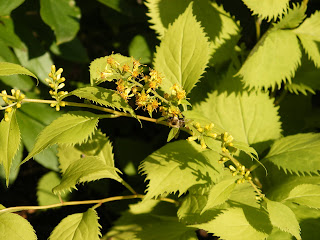
As many of you know, Carol at May Dreams Garden recently held a free giveaway contest to win a Cobrahead short-handled weeder. And the family that owns and operates Cobrahead most graciously gave a free weeder to all participants. I am a lucky recipient, so my review of this tool is completely un-objective, which I want to state at the outset.
Free or otherwise, I have to say that this Cobrahead short-handled weeder is an extremely efficient tool for a busy, harried gardener. I am a working mother with two kids under the age of 5. Needless to say, weeding often falls by the wayside in the litany of activities and chores that must get accomplished on a daily basis around here. Weeding, when it happens, usually takes place during my youngest's nap while my oldest "helps" me (which is actually quite cute and a great way to get kids involved in the outdoors, despite the inefficiency). So my weeding efforts must be fast and effective, because they certainly aren't frequent, and this Cobrahead tool allowed me to be exactly that!
After 3-plus days of rain, I finally wandered back into the garden yesterday to fight back the water-fueled weeds I knew were taking over. It was nap time, I had my helper, and little time to spare. But the dandelions, errant turf grass, and purslane were no match! The Cobrahead short-handled weeder sliced beneath them, uprooted them effortlessly, and allowed me to get those hard-to-reach places behind our obnoxiously typical foundation-planting yews.
The curved shape of the weeder facilitated getting into the weeds' root systems and popping them out of the ground. I'm sure the extremely moist soil helped make this process easier, but the ergonomics of the tool itself did the real work. Consequently, my entire front bed was weeded well before my helper's attention span tired of weeding and turned to checking the pepper plants and playing whiffle ball.
So there you have it! The Cobrahead short-handled weeder gets two thumbs up! If you're a busy gardener (and who isn't? It's not like I'm the only one with a hectic schedule. We all do!), you should seriously consider investing in one of these, if you haven't already won one thanks to Carol and Cobrahead!









































